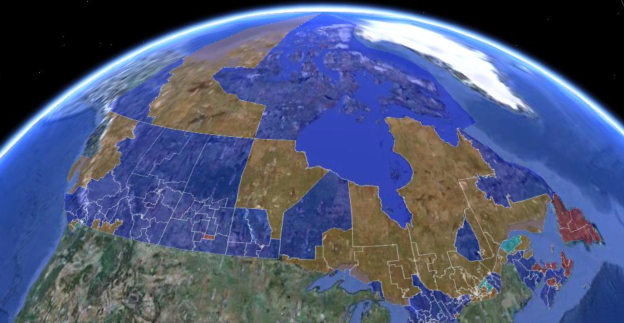February 15th marked the 50th anniversary of Canada’s adoption of the maple leaf flag, an occasion that was made a national holiday in 1996.1 While I never knew about “flag day” before, it struck me this year because I had attended a number of events just prior to “flag day” in which the “red and white” featured prominently. At the national #Shutdowncanada protests on February 13th as well as the 8th annual Memorial March for Missing and Murdered Indigenous Women on February 14th inverted Canadian flags were prominent symbols.
I should say, only indigenous people who were flying inverted flags, which, seemed like a much more appropriate symbolic gesture than if I – as a white settler – were to fly an inverted flag. As it was, the presence of inverted flags (there were both Canadian and US flags) were poignant symbols that alluded to the underlying issues of colonialism and the ongoing legacy of unilateral use of sovereign violence. In addition to the direct impact that the Canadian flag turned upside down likely has for many people, those flying them had added additional messages. For instance, one flag read “Out of Order since 1763” referring to the (broken) nation-to-nation agreement between the Crown and Indigenous groups in the Royal Proclamation of 1763.2 Another inverted flag, featured in the image above and carried at the Winnipeg March for Missing and Murdered Indigenous Women (MMIW), pointed to the relationship between colonial and gendered forms of violence. An elderly Indigenous man and women held the sign through out the march, in this photo they happen to be standing across the street from “Colony Square” – a shopping centre on Portage Avenue in Winnipeg’s downtown.
Canada’s flag day celebrations received $250 000 in government funding, while the Memorial Marches continue to be organized on shoestring budgets in some of Canada’s poorest neighbourhoods. Still, some CBC commentators lamented the fact that, “the government has poured money into ad campaigns about the War of 1812 and the 200th birthday of Sir John A. Macdonald. The 1812 campaign cost more than $5 million; the Sir John A. ads cost more than $4 million. For the celebrations of the flag’s 50th, there’s a much more modest $50,000, plus another $200,000 for provincial celebrations.”1
While Harper may not be sponsoring inverted flag day anytime soon, this symbol has made it into the growing cultural and artistic resurgence surrounding indigenous and ally resistance across Turtle Island. For instance the US based Indigenous hip-hop group “Savage Family”3 prominently features inverted American flags in their music videos, and the Toronto based group “Test Their Logik” often performs their song “Turtle Island” at rallies and marches across Canada, which criticizes the colonial symbolics of Canadian nationalism.4
1. http://www.cbc.ca/news/politics/canada-s-flag-debate-flaps-on-50-years-later-1.2957192
2. http://indigenousfoundations.arts.ubc.ca/home/government-policy/royal-proclamation-1763.html
3.https://www.youtube.com/watch?v=-cVt_KeoyQg
4.. http://testtheirlogik.bandcamp.com/track/turtle-island

